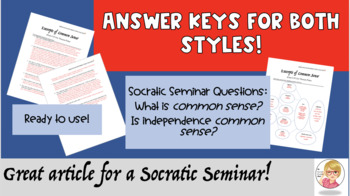American Revolution Primary Source Analysis: Excerpts of Common Sense
The Social Studies Stash
185 Followers
Grade Levels
8th - 12th, Homeschool
Subjects
Resource Type
Standards
CCSSRH.11-12.1
CCSSRH.11-12.2
CCSSRH.11-12.3
CCSSRH.11-12.4
CCSSRH.11-12.5
Formats Included
- Zip
Pages
20 pages
The Social Studies Stash
185 Followers
Description
In this activity, students will close read and analyze excerpts of the Thomas Paine’s Common Sense to create or fill in a mind map and answer text-dependent question in order to determine: What is common sense? Is independence common sense?
This activity includes:
- Primary source excerpts – 5 pages or 4 sets of Base/Expert Groups
- Ten Text-Dependent
- Mind Map Template – a great differentiation tool!
- Answer Keys – TDQs and Mind Map!
This activity can be completed in four ways:
- Individual Document Analysis – Assign the document in class, or as a homework (for a flipped classroom) and then host a Socratic seminar on the Seminar question the following day.
- Base/Expert Groups – Divide students into four teams and distribute a section of Common Sense to each. Invite groups to read and analyze their section, then move to their base groups and share the knowledge they’ve gained.
- Pair or Small Group Document Analysis
FORMATS INCLUDE: PDF, WORD-editable
FOLLOW & Rate me on TPT!
Rate the Product & Leave feedback to earn TpT money!
I love hearing from you! It helps me to grow and improve my resources. Once you've made a purchase, be sure you're logged in, rate the resource & leave feedback, to earn TpT credit - TpT Money!
If you have any questions about my products, please do not hesitate to contact me!
Total Pages
20 pages
Answer Key
Included
Teaching Duration
2 days
Report this resource to TPT
Reported resources will be reviewed by our team. Report this resource to let us know if this resource violates TPT’s content guidelines.
Standards
to see state-specific standards (only available in the US).
CCSSRH.11-12.1
Cite specific textual evidence to support analysis of primary and secondary sources, connecting insights gained from specific details to an understanding of the text as a whole.
CCSSRH.11-12.2
Determine the central ideas or information of a primary or secondary source; provide an accurate summary that makes clear the relationships among the key details and ideas.
CCSSRH.11-12.3
Evaluate various explanations for actions or events and determine which explanation best accords with textual evidence, acknowledging where the text leaves matters uncertain.
CCSSRH.11-12.4
Determine the meaning of words and phrases as they are used in a text, including analyzing how an author uses and refines the meaning of a key term over the course of a text (e.g., how Madison defines faction in Federalist No. 10).
CCSSRH.11-12.5
Analyze in detail how a complex primary source is structured, including how key sentences, paragraphs, and larger portions of the text contribute to the whole.





